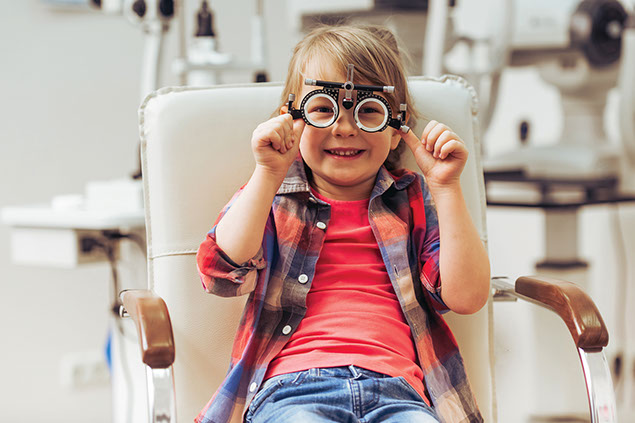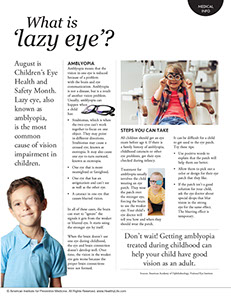SYMPTOM CHECKER
CONDITIONS
Male
Female
Child
Arm, Hand & Shoulder Concerns
Legs & Feet Concerns
Dental & Mouth Concerns
Ear & Nose
Eye Conditions
Head Conditions
Arm, Hand & Shoulder Concerns
Legs & Feet Concerns
Front
Back
Arm, Hand & Shoulder Concerns
Dental & Mouth Concerns
Ear & Nose
Eye Conditions
Head Conditions
Arm, Hand & Shoulder Concerns
Dental & Mouth Concerns
Ear & Nose
Eye Conditions
Head Conditions
Front
Back
Arm, Hand & Shoulder Concerns
Neck Links
Head & Neck Concerns
Arm, Hand & Shoulder Concerns
Neck Links
Head & Neck Concerns
Front
Back
Online Clinic
Wise Healthcare
What is ‘lazy eye’?

Print on Demand
Lazy eye, also known as amblyopia, is the most common cause of vision impairment in children.
Amblyopia
Amblyopia means that the vision in one eye is reduced because of a problem with the brain and eye communication. Amblyopia is not a disease, but is a result of another vision problem. Usually, amblyopia can happen when a child has:
• Strabismus, which is when the two eyes can’t work together to focus on one object. They may point in different directions. Strabismus may cause a crossed eye, known as esotropia. It may also cause one eye to turn outward, known as exotropia.
• One eye that is more nearsighted or farsighted.
• One eye that has an astigmatism and can’t see as well as the other eye.
• A cataract in one eye that causes blurred vision.
In all of these cases, the brain can start to “ignore” the signals it gets from the weaker or blurred eye. It starts using the stronger eye by itself.
When the brain doesn’t use one eye during childhood, the eye and brain connection doesn’t develop well. Over time, the vision in the weaker eye gets worse because the proper brain connections were not formed.
Steps you can take
All children should get an eye exam before age 4. If there is a family history of amblyopia, childhood cataracts or other eye problems, get their eyes checked during infancy.
Treatment for amblyopia usually involves the child wearing an eye patch. They wear the patch over the stronger eye, forcing the brain to use the weaker eye. Your child’s eye doctor will tell you how and when they should wear the patch.
It can be difficult for a child to get used to the eye patch. Try these tips:
• Use positive words to explain that the patch will help them see better.
• Allow them to pick out a color or design for their eye patch that they like.
• If the patch isn’t a good solution for your child, ask the eye doctor about special drops that blur vision in the strong eye for the same effect. The blurring effect is temporary.
Don’t wait! Getting amblyopia treated during childhood can help your child have good vision as an adult.
Sources: American Academy of Ophthalmology, National Eye Institute
RELATED ARTICLES
This website is not meant to substitute for expert medical advice or treatment. Follow your doctor’s or health care provider’s advice if it differs from what is given in this guide.
The American Institute for Preventive Medicine (AIPM) is not responsible for the availability or content of external sites, nor does AIPM endorse them. Also, it is the responsibility of the user to examine the copyright and licensing restrictions of external pages and to secure all necessary permission.
The content on this website is proprietary. You may not modify, copy, reproduce, republish, upload, post, transmit, or distribute, in any manner, the material on the website without the written permission of AIPM.
2021 © American Institute for Preventive Medicine - All Rights Reserved. Disclaimer | www.HealthyLife.com















































